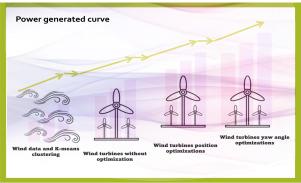A novel optimization method for maximizing wind farm performance through turbine positioning and yaw angle estimation
IF 10.9
1区 工程技术
Q1 ENERGY & FUELS
引用次数: 0
Abstract
This study presents novel approaches to optimize wind farm performance by utilizing smart initialization techniques combined with optimization algorithm Levenberg–Marquardt to enhance position of the wind turbines, although fast yaw angle estimation technology with the Levenberg–Marquardt algorithm to enhance the yaw angle estimation of the turbines in order to increase the power generation of wind farm has been implemented. The k-means clustering was used for the evaluation of wind parameters, allowing for a precise estimation of wind speed and direction while significantly reducing computational time. The proposed combination of smart initialization with Levenberg–Marquardt algorithm technologies obtained the best results in the position of the turbines compared to other optimization algorithms. Although, fast yaw angle estimation can be independently or combined with the optimization algorithm improve the yaw angle estimation. The yaw angle of the first wind turbine (in a given wind direction) that maximizes the power generated by the remaining wind turbines is determined, then estimating the yaw angle of the second wind turbine that maximizes the power generated will continue and so on; then the results refined by the Levenberg–Marquardt algorithm. The results demonstrate significant improvements in overall wind farm performance by 44.9 MW in a 80 wind turbine farm compared to the non-optimized wind farm and by 5.6 MW when smart initialization added to Levenberg–Marquardt, highlighting the effectiveness of combining these advanced techniques for better resource management and energy efficiency in wind energy systems.

一种利用风力机定位和偏航角估计实现风电场性能最大化的优化方法
本研究提出了利用智能初始化技术结合优化算法Levenberg-Marquardt来增强风力涡轮机位置的新方法,尽管已经实现了利用Levenberg-Marquardt算法来增强风力涡轮机偏航角估计以增加风力发电场发电量的快速偏航角估计技术。k-means聚类用于风参数的评估,允许精确估计风速和风向,同时显着减少计算时间。所提出的智能初始化与Levenberg-Marquardt算法技术相结合,在风机位置上的优化效果优于其他优化算法。虽然快速偏航角估计可以单独使用,也可以与优化算法结合使用,以提高偏航角估计的精度。确定使其余风力机产生的功率最大化的第一风力机的偏航角(在给定的风向下),然后继续估计使所产生的功率最大化的第二风力机的偏航角,以此类推;然后用Levenberg-Marquardt算法对结果进行细化。结果表明,与未优化的风力发电场相比,80个风力发电场的整体风力发电场性能显著提高了44.9兆瓦,当智能初始化加入Levenberg-Marquardt时,整体风力发电场性能提高了5.6兆瓦,突出了将这些先进技术结合起来的有效性,以更好地管理风能系统的资源和能源效率。
本文章由计算机程序翻译,如有差异,请以英文原文为准。
求助全文
约1分钟内获得全文
求助全文
来源期刊

Energy Conversion and Management
工程技术-力学
CiteScore
19.00
自引率
11.50%
发文量
1304
审稿时长
17 days
期刊介绍:
The journal Energy Conversion and Management provides a forum for publishing original contributions and comprehensive technical review articles of interdisciplinary and original research on all important energy topics.
The topics considered include energy generation, utilization, conversion, storage, transmission, conservation, management and sustainability. These topics typically involve various types of energy such as mechanical, thermal, nuclear, chemical, electromagnetic, magnetic and electric. These energy types cover all known energy resources, including renewable resources (e.g., solar, bio, hydro, wind, geothermal and ocean energy), fossil fuels and nuclear resources.
 求助内容:
求助内容: 应助结果提醒方式:
应助结果提醒方式:


